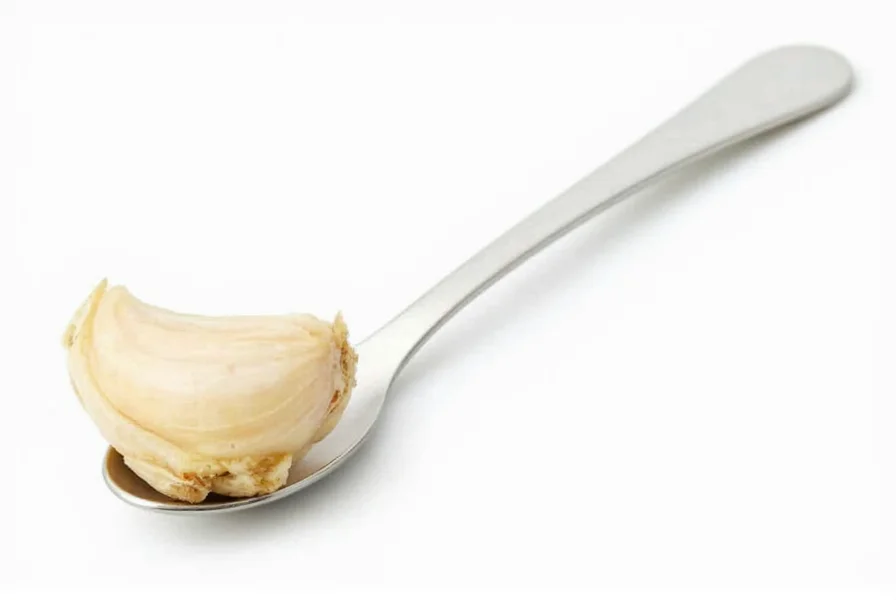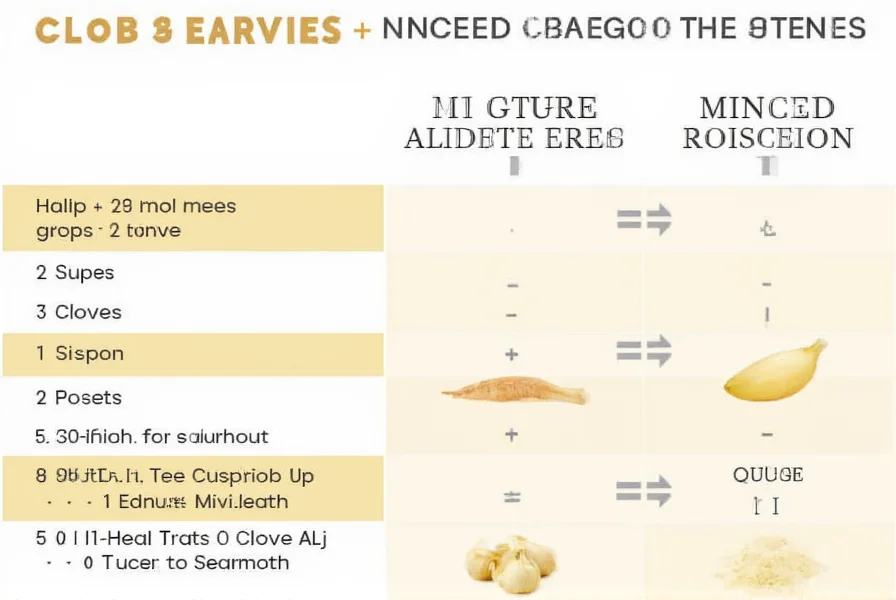When following recipes, precise garlic measurements make a significant difference in flavor balance. Understanding the exact how many tsp is 2 cloves of garlic conversion prevents overpowering dishes or ending up with insufficient garlic flavor. The standard conversion depends on whether you're using fresh garlic, jarred minced garlic, or garlic powder.
Understanding Garlic Measurement Conversions
Garlic measurements vary based on preparation method and clove size. A medium garlic clove (about 1 inch long and 3/4 inch in diameter) yields approximately:
| Garlic Form | 1 Clove Equivalent | 2 Cloves Equivalent |
|---|---|---|
| Fresh garlic, minced | 1/2 teaspoon | 1 teaspoon |
| Garlic powder | 1/8 teaspoon | 1/4 teaspoon |
| Bottled minced garlic | 1/2 teaspoon | 1 teaspoon |
| Garlic paste | 1/2 teaspoon | 1 teaspoon |
These garlic clove to teaspoon conversion measurements assume medium-sized cloves. Garlic size varies significantly—small cloves might yield only 1/3 teaspoon minced, while large cloves can produce up to 3/4 teaspoon. Always consider your specific garlic when making cooking measurement conversion for garlic.
Why Garlic Conversions Matter in Cooking
Accurate garlic measurement affects both flavor intensity and chemical reactions in cooking. Fresh garlic contains allicin, which develops when cells are ruptured (through chopping or crushing). Processed garlic forms have different allicin concentrations:
- Fresh garlic: Highest allicin content, most pungent flavor when raw, mellows when cooked
- Minced garlic (jarred): About 70% as potent as fresh due to preservatives and oxidation
- Garlic powder: Concentrated flavor (3-4 times stronger than fresh), dissolves completely
When substituting, remember that how much minced garlic equals 2 cloves of fresh isn't a perfect 1:1 ratio due to moisture content differences. Jarred minced garlic contains water, while powder is dehydrated.

Practical Substitution Guidelines
For best results when converting between forms:
- For fresh to jarred minced garlic: Use equal volume (2 cloves = 1 tsp), but add 5-10 minutes earlier in cooking to compensate for reduced potency
- For fresh to garlic powder: Use 1/8 tsp powder per clove, but add gradually and taste—powder can become bitter if overused
- For roasted garlic: 2 roasted cloves equal about 1.5 tsp mashed (roasting reduces volume by 25-30%)
Professional chefs recommend these adjustments for different cooking methods:
- Sauces and soups: Stick to exact conversions
- Dry rubs: Increase powder by 25% since flavor doesn't disperse as well
- Baking: Reduce powder by 20% as heat intensifies its flavor
Common Measurement Mistakes
Cooks frequently make these errors with garlic measurement chart for recipes:
- Using large cloves but standard conversion (can double garlic intensity)
- Not accounting for garlic age (older garlic has stronger flavor)
- Substituting powder 1:1 with fresh (results in overpowering dishes)
- Measuring minced garlic heaped rather than leveled
For consistent results, always mince fresh garlic yourself when possible. Pre-minced products contain citric acid that alters flavor chemistry. If using bottled garlic, drain excess liquid before measuring for accurate garlic powder substitution for fresh garlic.

When Precision Matters Most
Certain dishes require exact garlic measurements:
- Mayonnaise and aioli: Excess garlic causes rapid spoilage
- Pickling solutions: Affects preservation chemistry
- Delicate fish dishes: Overpowering garlic ruins subtle flavors
- Fermented foods: Alters microbial balance
In these cases, use a kitchen scale for most accurate results—2 medium cloves weigh approximately 10 grams. Remember that how many tsp is 2 cloves of garlic varies slightly based on your specific garlic variety and freshness.
Frequently Asked Questions
How many teaspoons is 2 garlic cloves when minced?
Two medium garlic cloves yield approximately 1 teaspoon of freshly minced garlic. This measurement assumes level teaspoons, not heaping. Small cloves may produce only 3/4 teaspoon, while large cloves can yield up to 1 1/4 teaspoons.
Can I substitute garlic powder for 2 cloves of fresh garlic?
Yes, substitute 1/4 teaspoon of garlic powder for 2 fresh garlic cloves. Remember that garlic powder is more concentrated, so add gradually and taste as you cook. For best results, mix the powder with a small amount of water first to rehydrate it before adding to your dish.
Does the size of garlic cloves significantly affect the teaspoon measurement?
Yes, clove size dramatically affects measurements. Small cloves (under 1 inch) yield about 1/3 teaspoon minced per clove, medium cloves (1-1.25 inches) yield 1/2 teaspoon, and large cloves (over 1.5 inches) can produce 3/4 teaspoon or more. Always adjust your how many tsp is 2 cloves of garlic conversion based on actual clove size.
How do I measure garlic accurately for recipes?
For most accurate measurements, mince fresh garlic and press it into the measuring spoon with the back of a knife to eliminate air pockets. For bottled minced garlic, drain excess liquid first. When using garlic powder, spoon it into the measure and level with a straight edge—don't pack it down. For critical recipes, use a kitchen scale (1 medium clove = 5g).
Why does my garlic substitution taste different than expected?
Garlic substitutions often taste different due to moisture content and chemical composition variations. Fresh garlic contains enzymes that create complex flavors when cooked, while processed forms lack these. Bottled minced garlic has citric acid that alters flavor, and garlic powder is more concentrated. Adjust cooking times and quantities based on the garlic powder substitution for fresh garlic guidelines for best results.










 浙公网安备
33010002000092号
浙公网安备
33010002000092号 浙B2-20120091-4
浙B2-20120091-4